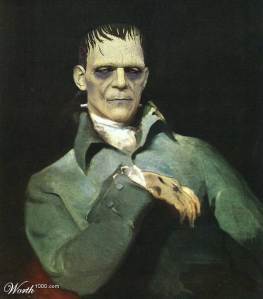You Are Dr. Frankenstein: Bring Your Characters to Life

Give your Frankenstein’s monster some style.
With a vision, some madness, a computer, and electricity (or a strong battery), you too can be Dr. Frankenstein. As a writer, I am constantly searching for parts and pieces that will create a magnificent creature, eh, character. But once I stitch all the pieces together, I have only a one-dimensional lump. I then need to infuse that lump with emotion, expression, passion. I can do it. You can do it. *cue maniacal laughter* It is the power of the imagination.
Scan the images that you see every day.
Every day we hold images in our hands, literally. Androids, iPads, Kindles, and Notebooks. We live in such a visual society that images constantly bombard us. Is it hard to separate an image that originated in the mind from one that already exists. Maybe. But that’s okay. Writing is synthesizing what you imagine and what you see.
Once I wrote my first genie novel, I would assess actors and models as to who would make the best Zubis the jinni. That’s normal. Every author eagerly imagines that their novel may someday be a movie or show. As a matter of fact, I just came across images last week of Felix Baumgartner and thought, “He looks like he should live in Jinnistan.” I sense a character coming: “corded with muscle” “rugged” “confident fearlessness.” The beginning of a new creature, eh, character.

Baumgartner: Definite jinni material.
Create a checklist of characteristics.
I created Zubis because I had read a lot about genies and Middle Eastern myth. I had a sense of what he should look like. Dark hair: check. Broad shoulders: check. Tall: check. Scar: check. Intense expression: check. But he began to come to life (“Uhhhrrrr-uhhhhrrrr”) when I scanned the faces I saw around me, in media and on the street. Did I see Zubis as an actor playing a role on the SyFy channel before his features drifted from my consciousness onto the page? Maybe. And if it did, would that be a bad thing? Nathaniel Hawthorne probably saw people on the street, albeit garbed in muslin and flannel from collar to ankle, who made their way into his physical descriptions.
The people we see every day inform our characters. Just as interactions we have every day inform our narrative. A writer doesn’t write in a vacuum. We incorporate what we see and experience into our stories. We are purveyors of emotion and form. We are creators. *cue maniacal laughter*
Collect images, not body parts
Get the body, add the emotion.[Jason Momoa]
I would recommend that a writer working on a novel should clip and paste into a file those faces and figures that fit our characters. If you have an established, recurring protagonist, then keep track of how they react in various situations. Develop a character profile. And don’t be afraid to base those traits on real people. After all, our characters are real when they’re in our head. Make them real for your readers.Pulling these images from the ether is also a good exercise for a book trailer. Even if you never distribute it, a trailer develops your understanding of the world your characters live in. Connecting what is in your head with what can be realized is one more step in competent world building. Most people have Windows Movie Maker on their laptops (or a more-polished Apple program) or a similar program that can easily accommodate your own production. Think it. Make it. Bring it to life. *cue maniacal laughter*
And when I cobble my images together and add some modern technological wizardry, this is what I get:

Best Wishes,
Kellyann
Bring Zubis to life in your ereader.
On Kindle. On Nook.






